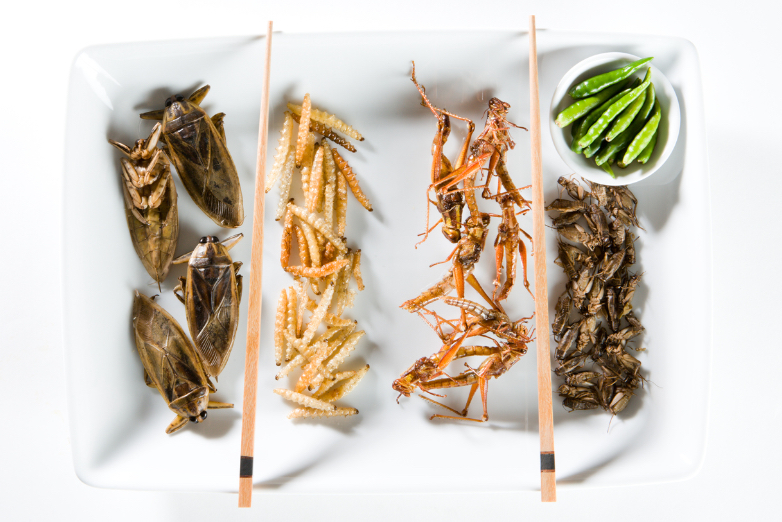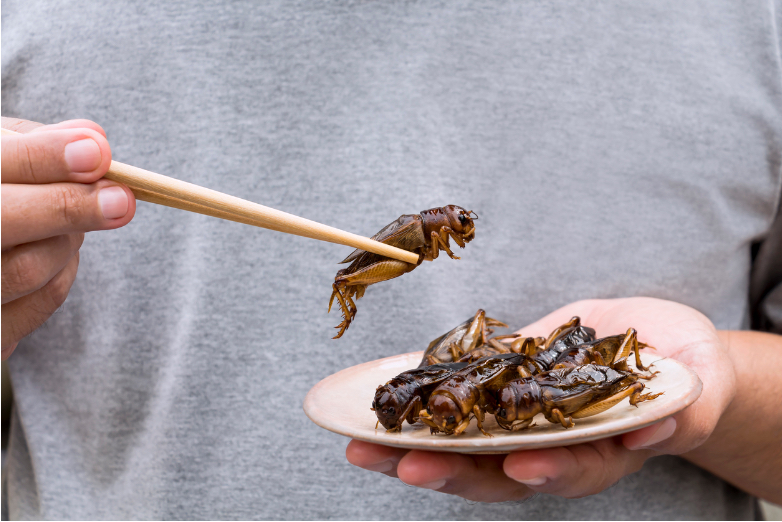They are eaten by more than two billion people in 80% of the world’s countries, but no, they are not on the menu of some famous burger chain. Add to that the fact that they have been part of the human diet for thousands of years, and it becomes clear that we are talking about a different kind of food. Yet despite their long history, we in Western societies have missed out on a source of nutrients that could be the solution to the future of our food supply, if we can just let go of our aversion to eating bugs.
By the middle of this century, the Earth will have more than nine billion human mouths to feed. And food production is unlikely to grow at the same rate. According to the Food and Agriculture Organisation of the United Nations (FAO), 26% of the world’s dry, habitable land is used for livestock grazing, and 33% of arable land produces crops for livestock. Livestock are responsible for 14% of greenhouse gas emissions over their entire life cycle, and clearing more forests to make way for agriculture would add to the problem of climate change.
Under our current system, the numbers don’t add up. But many people now believe that it is possible to get past this difficult crossroads without giving up animal foods—it is simply a matter of varying the menu of the species we eat. In the West, we are already used to eating arthropods, but only aquatic ones, such as crabs or lobsters. In contrast, up to 3,000 ethnic groups in Latin America, Africa, Asia and Oceania include insects in their diet.
Wageningen University in the Netherlands maintains a list of 2,111 edible species of insects and arachnids, mainly beetles, caterpillars, ants, bees, wasps, grasshoppers, locusts and crickets, but also flies, spiders and cockroaches; other researchers have produced a shorter list of just over 1,600 insects. The FAO, which has been promoting entomophagy as a solution to food insecurity for years, has been instrumental in extolling the nutritional virtues of these critters.
RICH IN NUTRIENTS
Analyses reveal that insects are rich in protein, unsaturated fatty acids, amino acids and vitamins, with iron and other minerals equal to or greater than those found in sirloin beef. According to Peter Alexander, a global food safety expert at the University of Edinburgh, crickets contain 65% protein by weight, compared to 23% for beef and 8% for tofu. And it’s all packed into tiny creatures that can be raised on little water, even waste food, and with a minimal ecological footprint: according to the FAO, pigs produce between 10 and 100 times more greenhouse gases per kilo than mealworms (beetle larvae).

Alexander’s data shows that insect farming offers greater land and feed efficiency than other animal products to generate the same amount of calories and protein; for example, crickets and mealworms require 5-10 times less food than cows to gain the same weight, and use 70 times less agricultural land to produce the same amount of protein. “The adoption of entomophagy could help reduce the environmental impact of agriculture,” Alexander tells OpenMind. He recommends replacing some of the current consumption of animal products with insects. “A mix of smaller changes in consumer behaviour, such as replacing beef with chicken, reducing food waste and potentially introducing insects more commonly into diets, would also achieve land savings and a more sustainable food system,” he says.
Alexander acknowledges that getting Europeans to consume insects en masse will not be easy. He thinks that the biggest barrier will be cultural. “Here in the West, eating insects is not a social norm, and the thought of eating insects for many creates a disgust reaction, and hence their use on reality TV shows.” The scientist believes that the change will be slow, but he is confident that it will happen, just as the consumption of raw fish in the form of sushi has become popular in recent decades. “There are now restaurants and retailers in Europe and the US that specialise in selling insects for human consumption, and even cookbooks,” he says.

The introduction of entomophagy could be facilitated by presenting the product in a way that is more appealing to the Western mentality. Instead of the fried whole insects that are sold in the markets of many Asian cities, some companies have already opted for the ground product, such as cricket meal, which is used to make energy bars. But for Alexander, “the absolute size of the market remains extremely small.”
SOME OBSTACLES
However, this new crunchy manna may still face some serious hurdles. According to a University of California study, the large-scale production of crickets only offers a slightly higher protein conversion rate than chicken if the insects are fed grain rather than food waste. So the dream of turning our rubbish into tonnes of delicious insects may not be so imminent. Sustainability is also discussed in the book On Eating Insects — Essays, Stories and Recipes (Phaidon, 2017) by the Nordic Food Lab, the research arm of Danish restaurant Noma. The authors urge caution: “The idea that all insect species are universally sustainable is misleading.”
This is compounded by more recent animal welfare concerns. Although insects do not inspire the same level of sympathy in most people as vertebrates, they do feel pain, and experts therefore argue that insect farms need to adopt similar practices to those used in conventional farming to avoid animal suffering.

But the environmental and ethical implications are not the only hurdles to overcome. Nils Grabowski, a specialist in edible insects at the University of Veterinary Medicine Hannover in Germany, tells OpenMind that legislation on these products has lagged behind their development. In Europe, Switzerland was a pioneer in legalising entomophagy, and other countries such as Belgium, the Netherlands, Denmark and Finland introduced their own regulations before there was a common framework.
New legal framework
In 2018, the European Union introduced insects as novel foods in its new law governing foods that are not commonly consumed in the EU, which are subject to individual approval. Since then, the EU has authorised six foods from four species: the migratory locust (Locusta migratoria), the house cricket (Acheta domesticus), the mealworm (the larva of the beetle Tenebrio molitor) and the larva of another beetle, Alphitobius diaperinus, the last of which was approved in January 2023. A further eight applications are pending. In response to misinformation about edible insects, the European Commission has clarified that no one will be forced to eat insects without their knowledge, as foods containing these products will be clearly labelled.
In other countries, edible insects are not specifically regulated, nor are they usually considered novel foods, so they fall under general food legislation. This is the case in the US, Canada, Australia and New Zealand, but also in many African, Asian and South American countries where insects are traditionally consumed. In the UK, Brexit has left a vacuum where it is not entirely clear whether edible insects are legal, although there is a tendency to interpret that they are not.

According to experts, such regulations are particularly necessary because the consumption of insects can pose a risk of microbiological contamination if inappropriate processing methods are used. Grabowski co-authored a study that analysed the presence of microbes in various samples of edible insects. The results suggested that dried or powdered insects, as opposed to cooked or fried insects, exceeded some bacterial contamination limits according to the criteria proposed in Belgium and the Netherlands, although no pathogens were found in alarming quantities.
Grabowski stresses that the method of processing is key. “While deep-frying and cooking usually reduce the bacteria counts, grinding and/or drying increases some levels, especially the spore-forming microbes.” The expert warns that this also applies to other foods, and that each product is different. The new European regulation guarantees the safety of these foods, but as a general rule, Grabowski recommends eating them cooked, never raw as some gourmets suggest: “We should heed the advice of those who have been consuming insects for millennia,” he concludes.
Comments on this publication